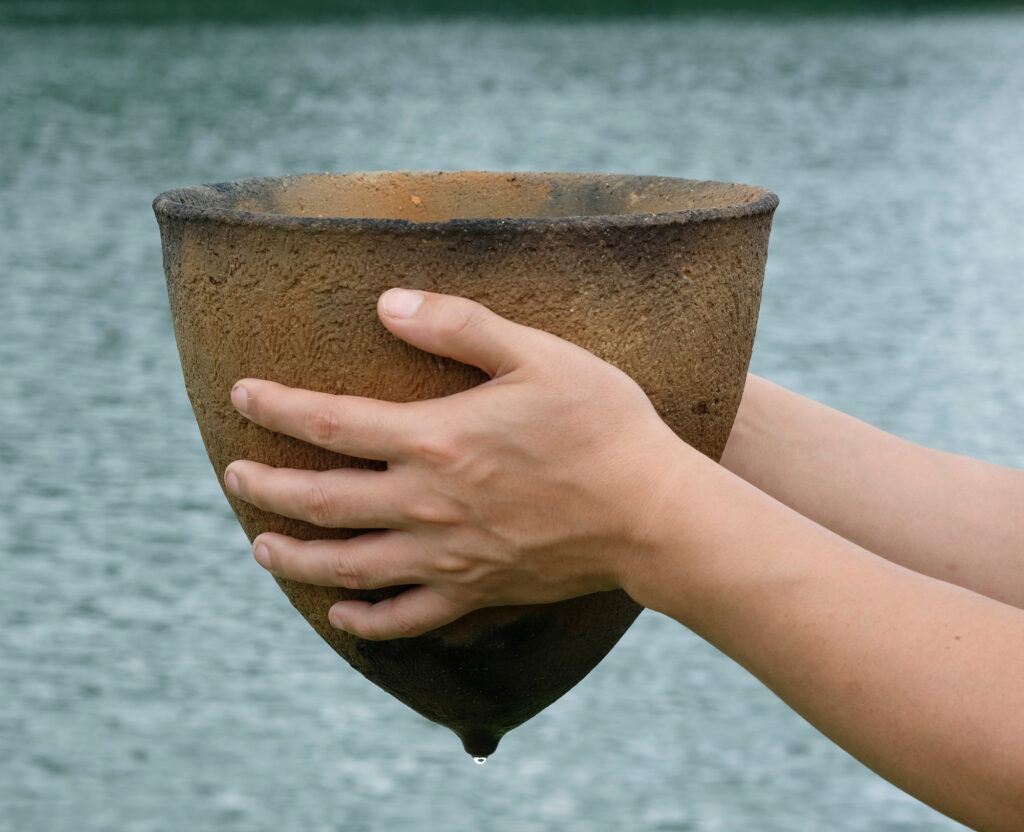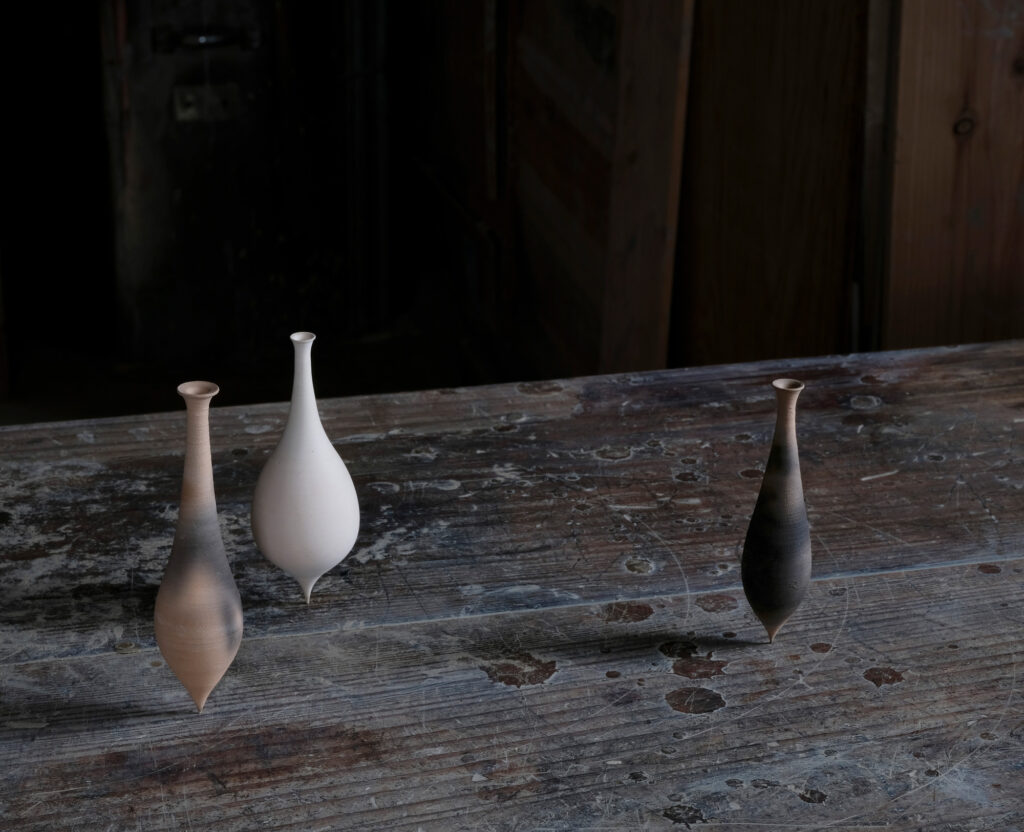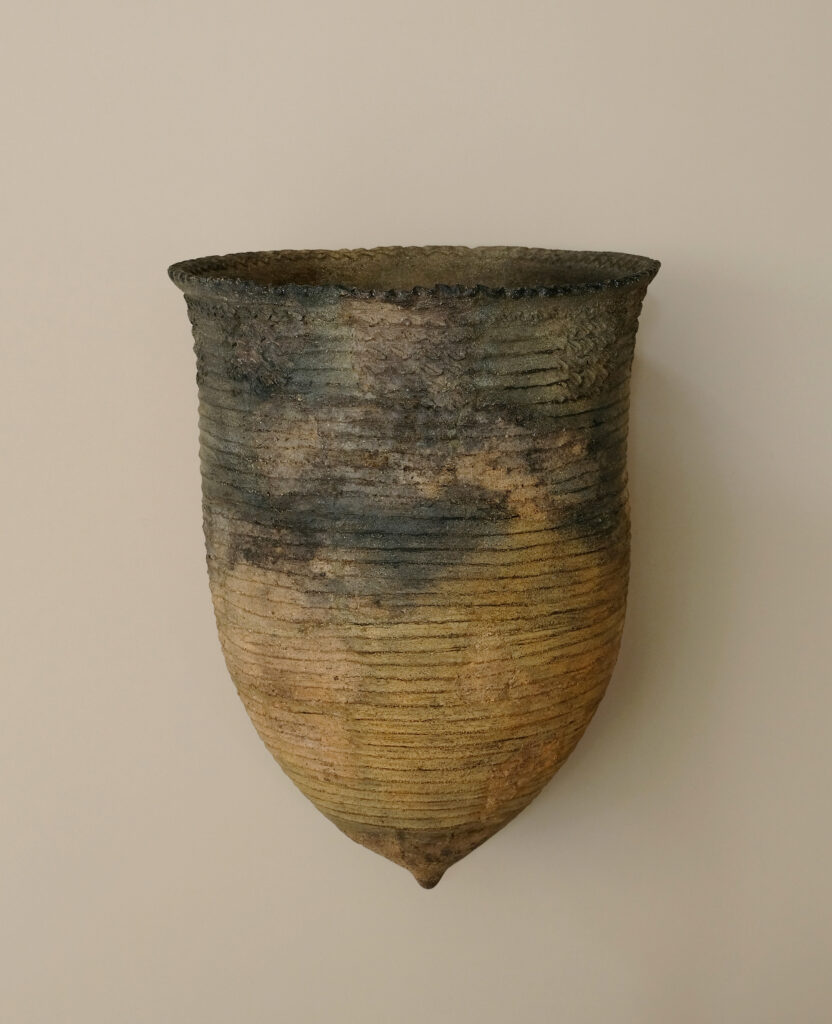Droplet from the Pointed Bottom Pot
Driving from Hokkaido’s easternmost city of Nemuro, I took a weeklong detour before arriving in Hakodate, and from there, hopped directly on a ferry for the Shimokita Peninsula. The strait I crossed marks the prefectural boundary between Hokkaido and Aomori at present. But back in their day, the Jomon people must have gone back and forth frequently in much smaller boats. Try rewinding time and mapping the spread of the Jomon culture based on pottery patterns. It’s plain to see that the waters didn’t divide the two lands but rather served as a maritime route to connect them.
At the base of the Shimokita Peninsula lies Lake Ogawara, with a series of marshes stretching northward. The area around them has produced pottery dating back to the Incipient Jomon (about 13,000–9,000 years ago). A while ago, I discovered one of those pots in an old book and fell in love with it at first sight. And on this trip, I met it face-to-face at last. Deep vessel with pointed bottom and raised line decoration (Rokkasho Village Omotedate No. 1 site, collection of Aomori Prefectural Museum) —let’s take a close look at its beauty of form.

A horizontal stripe pattern begins at the rim, with the first several bands featuring a wavy design, and continues down into a linear pattern made by carefully applying cords of clay around the body. During my photo shoot, the curator told me that after as long as ten thousand years, most pots are found with the tip chipped or missing, and in the whole of Japan, only a few have been unearthed intact in their entirety, from the rim to the bottom. Farther down the vessel, the bands taper to a breast-shaped bottom. Jomon pottery may bring to mind a flat bottom for most people, but vessels with pointed bottoms were widely used from early on. How those pointed bottom pots were used, however, is not yet fully understood. One theory says the pots were placed standing in the ashes of a fire pit and used for cooking, and another says the pointed bottoms were quicker to conduct heat than flat bottoms, but neither sounded very convincing.
Thinking a ceramic artist could help shed some light on the question, I visited my friend Yukiharu Kumagai in Yamanashi Prefecture. He’s an expert in primitive earthenware techniques such as baking in an open fire and in a kiln. Luckily, he had recently been commissioned by a museum to create some pointed bottom pots, and happened to have one of them left at hand. (He also makes a series of pots with exaggerated pointed tips.)

While shallower than the pot unearthed in Aomori Prefecture, Mr. Kumagai’s pot was rounded and bulging. I held it and peered inside and noticed that the gentle downward curve ended in a small cavity. I rolled the pot around on the grass on the riverbed, admiring and photographing it, and after a while, Mr. Kumagai came over and suggested giving it a “reviving dip in the water.” He scooped up the pot himself, playfully immersed it in the river, lifted it out again, and presto! The pot’s previously dry surface instantly turned a shade darker and felt pleasant and comfortable in the hand.
“Earthenware is made to hold water. When it serves its purpose, it comes to life. It wakes up, if you will,” says Mr. Kumagai. “You might think fire has the greatest influence on the outcome of pottery. But I focus all my attention on moisture content. Soil and clay are moist to begin with. The processes of shaping and drying are all about adjusting the moisture content. If the clay is too dry, you can’t carve it, you see. That’s why you need to finish carving quickly, while the clay is still damp.”
I asked Mr. Kumagai to fill his pot with water again. He came back with both hands wrapped around the vessel—it was full and heavy, like a ripe fruit. Then something caught my eye. Below his palms, from the pointed bottom, shining drops of water were falling, like droplets of mother’s milk that had welled and dripped from the breast. Apparently, this wasn’t Mr. Kumagai’s design. For a moment, I stared at awe at the drops of water filtering through, and I came to a true understanding that tools are made to be used. And I made a promise to myself. I’m going to keep at it and pursue my Jomon fieldwork.
< PAPERSKY no.60(2019)>

Jomon Fieldwork | Nao Tsuda × Lucas B.B. Interview
A conversation between ‘Jomon Fieldwork’ Photographer and writer Nao Tsuda and Papersky’s Editor-in-chief Lucas B.B. The two discuss the ways Jomon culture continues to play an important role in modern day Japan. The video was filmed at Papersky’s office in Shibuya in conjunction with Tsuda’s exhibition “Eyes of the Lake and Mother Mountain Plate” held at the Yatsugatake Museum in Nagano.
Nao Tsuda | Photographer
Through his world travels he has been pointing his lens both into the ancient past and towards the future to translate the story of people and their natural world.
tsudanao.com











